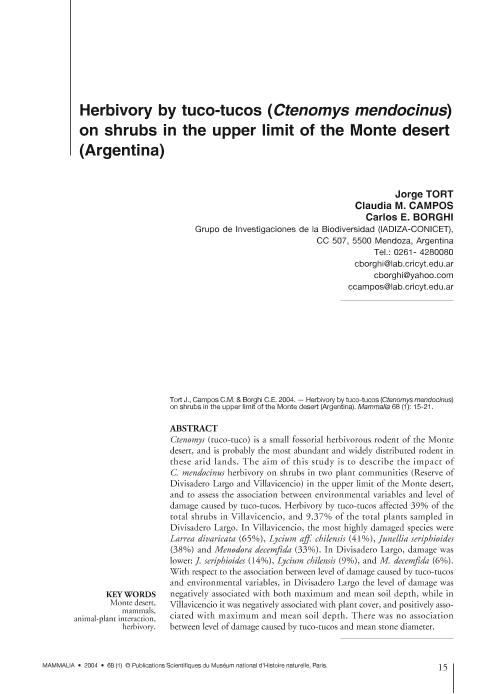Mostrar el registro sencillo del ítem
dc.contributor.author
Tort, Jorge
dc.contributor.author
Campos, Claudia Monica

dc.contributor.author
Borghi, Carlos Eduardo

dc.date.available
2020-04-02T18:58:28Z
dc.date.issued
2004-12
dc.identifier.citation
Tort, Jorge; Campos, Claudia Monica; Borghi, Carlos Eduardo; Herbivory by tuco-tucos (Ctenomys mendocinus) on shrubs in the upper limit of the Monte desert (Argentina); De Gruyter; Mammalia; 68; 1; 12-2004; 15-21
dc.identifier.issn
0025-1461
dc.identifier.uri
http://hdl.handle.net/11336/101708
dc.description.abstract
Ctenomys (tuco-tuco) is a small fossorial herbivorous rodent of the Monte desert, and is probably the most abundant and widely distributed rodent in these arid lands. The aim of this study is to describe the impact of C. mendocinus herbivory on shrubs in two plant communities (Reserve of Divisadero Largo and Villavicencio) in the upper limit of the Monte desert, and to assess the association between environmental variables and level of damage caused by tuco-tucos. Herbivory by tuco-tucos affected 39% of the total shrubs in Villavicencio, and 9.37% of the total plants sampled in Divisadero Largo. In Villavicencio, the most highly damaged species were Larrea divaricata (65%), Lycium aff. chilensis (41%), Junellia seriphioides (38%) and Menodora decemfida (33%). In Divisadero Largo, damage was lower: J. seriphioides (14%), Lycium chilensis (9%), and M. decemfida (6%). With respect to the association between level of damage caused by tuco-tucos and environmental variables, in Divisadero Largo the level of damage was negatively associated with both maximum and mean soil depth, while in Villavicencio it was negatively associated with plant cover, and positively associated with maximum and mean soil depth. There was no association between level of damage caused by tuco-tucos and mean stone diameter.
dc.description.abstract
Les tuco-tucos (genre Ctenomys) sont de petits caviomorphes fouisseurs et herbivores, probablement les plus abondants rongeurs vivant dans les terres arides du désert de Monte (Argentine : 32° S ; 69°W). Le but de ce travail est de décrire l’impact de l’herbivorie de C. mendocinus sur les plantes buissonnantes de deux communautés végétales des zones supérieures du désert de Monte, afin d’estimer la relation entre les variables environnementales et les niveaux des perturbations causées à la végétation par les tuco-tucos. Au site d’étude de Villavicencio, l’herbivorie a concerné 39 % des plantes buissonnantes, mais seulement 9 % des plantes échantillonnées au site de Divisadero Largo. A Villavicencio, les espèces végétales les plus abimées par les rongeurs ont été Larrea divaricata (65 %), Lycium aff. chilensis (41 %), Junellia seriphioides (38 %), et Menodora decemfida (33 %). Au site de Divisadero Largo, les dommages ont été moindres, et ont concerné les espèces J. seriphioides (14 %), Lycium chilensis (9 %), et M. decemfida (6 %). La relation entre l’étendue du dommage causé par les rongeurs et les variables environnementales est négativement corrélée avec les variables d’épaisseur (maximale, moyenne) du sol à Divisadero Largo, tandis qu’au site de Villavicencio, les dommages sont corrélés de façon négative avec le couvert végétal, et de façon positive avec l’épaisseur (maximale, moyenne) du sol. Aucune corrélation n’apparaît entre le niveau de consommation des plantes et le diamètre moyen des cailloux dans le sol.
dc.format
application/pdf
dc.language.iso
eng
dc.publisher
De Gruyter

dc.rights
info:eu-repo/semantics/openAccess
dc.rights.uri
https://creativecommons.org/licenses/by-nc-sa/2.5/ar/
dc.subject.classification
Ecología

dc.subject.classification
Ciencias Biológicas

dc.subject.classification
CIENCIAS NATURALES Y EXACTAS

dc.title
Herbivory by tuco-tucos (Ctenomys mendocinus) on shrubs in the upper limit of the Monte desert (Argentina)
dc.type
info:eu-repo/semantics/article
dc.type
info:ar-repo/semantics/artículo
dc.type
info:eu-repo/semantics/publishedVersion
dc.date.updated
2020-03-19T14:34:03Z
dc.journal.volume
68
dc.journal.number
1
dc.journal.pagination
15-21
dc.journal.pais
Alemania

dc.description.fil
Fil: Tort, Jorge. Consejo Nacional de Investigaciones Científicas y Técnicas. Centro Científico Tecnológico Conicet - Mendoza. Instituto Argentino de Investigaciones de las Zonas Áridas. Provincia de Mendoza. Instituto Argentino de Investigaciones de las Zonas Áridas. Universidad Nacional de Cuyo. Instituto Argentino de Investigaciones de las Zonas Áridas; Argentina
dc.description.fil
Fil: Campos, Claudia Monica. Consejo Nacional de Investigaciones Científicas y Técnicas. Centro Científico Tecnológico Conicet - Mendoza. Instituto Argentino de Investigaciones de las Zonas Áridas. Provincia de Mendoza. Instituto Argentino de Investigaciones de las Zonas Áridas. Universidad Nacional de Cuyo. Instituto Argentino de Investigaciones de las Zonas Áridas; Argentina
dc.description.fil
Fil: Borghi, Carlos Eduardo. Consejo Nacional de Investigaciones Científicas y Técnicas. Centro Científico Tecnológico Conicet - Mendoza. Instituto Argentino de Investigaciones de las Zonas Áridas. Provincia de Mendoza. Instituto Argentino de Investigaciones de las Zonas Áridas. Universidad Nacional de Cuyo. Instituto Argentino de Investigaciones de las Zonas Áridas; Argentina
dc.journal.title
Mammalia

dc.relation.alternativeid
info:eu-repo/semantics/altIdentifier/doi/https://doi.org/10.1515/mamm.2004.002
dc.relation.alternativeid
info:eu-repo/semantics/altIdentifier/url/https://www.degruyter.com/view/journals/mamm/68/1/article-p15.xml
Archivos asociados
